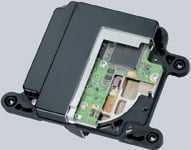Television ads are doing automotive engineering a disservice, focusing as most do on snappier looks, more horsepower, and occasionally on some mysterious quality that not even alert viewers can figure out. The truth is that the automotive industry is taking the lead in making its products more reliable, more efficient, more comfortable—and, in particular, safer.
 |
Antilock braking systems, introduced in 1978, were a significant improvement over their stomp-and-skid precursors. The mid-1990s saw the introduction of electronic stability control (ESC, Figure 1), which became the foundation for further advances in smart automotive design.
 Figure 1. The ESC sensor cluster |
In addition to instrumenting many of a vehicle's mechanical components with intelligent sensors, ESC establishes channels of communication among them. Continental calls this the Total Safety Approach. Let's take a closer look at some of the ways this technology is being showcased in the 2007 Mercedes-Benz S-Class automobiles.
Advanced Braking System
The MK25E5 brake control system (Figure 2) incorporates a brake pressure sensor at each wheel and another on the master cylinder. The infinitely variable apply-and-release valves provide extremely sensitive brake pressure signals that improve the vehicle's forward and side-to-side dynamics. This advantage translates into shorter stopping distances, barely perceptible braking intervention, and improved driving stability when maneuvering in hazardous situations. And there are additional comfort and safety functions.
 Figure 2. The MK25E5 brake control system |
Hill Start Assist. This feature, reminiscent of the "hill-holder" last offered in a domestic auto by Studebaker in the 1960s, prevents the vehicle from rolling backward when it's stopped on an incline. Directional wheel-speed sensors detect any rearward travel (Figure 3). When the driver steps on the brakes, cylinder pressure is maintained even after the brake pedal is released. The vehicle stays put. Once the driver applies the gas, the brake is released. No need to worry about that split second while your foot is changing pedals.
 Figure 3. Active wheel-speed sensors |
Ready Alert Brakes. This function causes a signal from the gas pedal to alert the system to a quick release after an emergency hard braking. It then prefills the brake hydraulics to make the system ready for another such event—with minimal refreshing time. The benefit is that your brakes are ready to stop you when the next inattentive or rash driver cuts you off.
Distance Control System
The driver-assist adaptive cruise control (ACC, Figure 4) is a radar-supported system that operates at speeds between zero and 200 km/hr. (124 mph). All you need to do is set the speed you want to travel and ACC will maintain a safe distance from the vehicle ahead.
 Figure 4. Radar-based adaptive cruise control |
If another automobile enters your lane of travel, your vehicle automatically decelerates. That could prove very handy should you come around a curve and find a traffic snarl.
Integrated distance sensors recognize and respond to changes in distance to the vehicle ahead much faster than you can, so ACC technology could greatly reduce the chances of a rear-end impact or collision by braking even before you have time to take in the situation. Continental offers both radar and lidar for this type of function; the S-Class uses radar.
In addition to the distance sensor, the package includes two proximity sensors that can bring the vehicle to a dead stop if necessary and hold it in place by maintaining brake pressure. You can get moving again by either stepping on the accelerator or pressing a manual button. This combination of short-and long-range sensors for adaptive cruise control is new to the industry.
And More
There are a couple more helpful features that, while not sensor based, are worth bringing to your attention. The retractable brake booster is designed to mitigate the effects of an accident that all the technology in the world can't prevent.
In the event of a front-end collision or impact, the active brake booster with brake-assist function and the tandem master cylinder with a torque damper retracts the entire actuation unit by means of a rotational action. This feature reduces the likelihood of injury to the driver's legs.
The electric parking brake releases and sets the parking brake with 100% reliability. When the drive train is activated, the brake automatically releases, which means that you won't lurch along for a block and wonder about that hot smell coming from under your vehicle. Another bonus is the elimination of the lever mechanism from your foot space. The system also detects possible malfunctions and displays an alert on the instrument panel.
Drive Safely!
The Total Safety Approach system gauges dangerous situations and implements appropriate safety precautions much more quickly than even the most skilled drivers can manage. It does not replace crash-protection schemes with crash-prevention technology, but instead lets the two complement each other. The next generation of electronic stability control, ESCII, will further integrate active and passive systems—steer-by-wire and even smarter air bags. After all, the best ride is the one with no mishaps and the best accident is the one you walk away from.
Dean McConnell, BS, can be reached at Continental Automotive Systems, Auburn Hills, MI; www.contitevesna.com, www.conti-online.com.